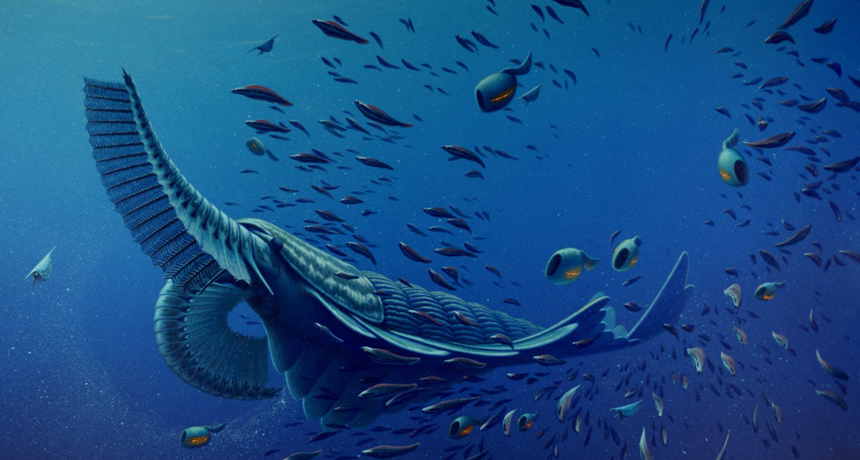Lobster’s ancient ‘cousin’ was gentle giant
It used tiny bristles to net its meals

Tamisiocaris borealis, a giant predator of the seas during the Cambrian period, swims among other ancient species in an artist’s reconstruction. This animal would have likely used the spiny limbs attached to its head (left) to sweep food into its mouth, scientists say.
Robert Nicholls/Paleocreations
Share this:
- Share via email (Opens in new window) Email
- Click to share on Facebook (Opens in new window) Facebook
- Click to share on X (Opens in new window) X
- Click to share on Pinterest (Opens in new window) Pinterest
- Click to share on Reddit (Opens in new window) Reddit
- Share to Google Classroom (Opens in new window) Google Classroom
- Click to print (Opens in new window) Print
Some of the largest early animals may have used spiny limbs to filter their food, not spike it. That certainly appears true for a 70-centimeter (2.3-foot) long distant relative of the lobster. It swam the seas roughly 520 million years ago, during what is known as the Cambrian period. Along the way, it used those limbs to net small animals for its breakfast, lunch and dinner.
Scientists found fossils of this Tamisiocaris borealis (Tah MEE see oh KARE is BOR ee AL is) in what is now northern Greenland. Those remains suggest the animal had two long, spiny limbs that jutted out from its face. Each would have been at least 12 centimeters (4.7 inches) long. But unlike on other predators, these limbs also had bristles. In other words, the limbs’ long, equally spaced, slender spines were covered in much finer and denser spines.
Those bristles appear to have served as a mesh. In many ways, they may have worked much like hairy fringes (known as baleen) found in modern filter-feeding whales.
T. borealiswould have used those bristly limbs to sweep through the water, collecting small crustacean-like creatures and other prey. The animal could then have curled the limbs inward — one at a time — to suck the food into its mouth. Or at least that’s the picture that Jakob Vinther at England’s University of Bristol and his co-workers finds most likely. They have developed a video animation (below) that shows how this would have worked.
The T. borealis fossils may be the earliest evidence for filter-feeding in large, free-swimming animals, the scientists say. Vinther’s team describes details of this denizen of the ancient seas in the March 27 Nature.
This video shows how T. borealis may have used its spiny appendages to sweep through the water, collect prey and then bring that food to its mouth. Credit: Martin Stein.
Power Words
baleen A long plate made of keratin (the same material as your fingernails or hair). Baleen whales have many plates of baleen in their mouths instead of teeth. To feed, a baleen whale swims with its mouth open, collecting plankton-filled water. Then it pushes water out with its enormous tongue. Plankton in the water become trapped in the baleen, and the whale then swallows the tiny floating animals.
Cambrian A period of Earth’s history that lasted from about 541 million to 510 million years ago. It is one of the earliest periods in which fossils can be used to date rocks.
crustaceans Hard-shelled water-dwelling animals including lobsters, crabs and shrimp.
denizen The inhabitant of a particular environment.
filter feeder A water-dwelling animal that collects its nutrients or prey by filtering them out of the water. Some of the best known examples are bivalves, such as clams and mussels. But some whales use long plates of baleen to essentially do the same thing. They suck in water and then use their filtering structures to catch and retain edible materials that had been in the water.
Greenland The world’s largest island, Greenland sits between the Arctic Ocean and North Atlantic. Although it is technically apart of North America, just east of Northern Canada, Greenland has been politically more linked to Europe. Indeed, Vikings arrived in Greenland around the 10th century, and for a time the island was a colony of Denmark. In June 2009, Greenland became an independent nation. Ice covers roughly 80 percent of Greenland. Indeed, the Greenland ice sheet is the world’s largest. If its frozen water were to melt, it could raise sea levels around the world by 6 meters (about 20 feet). Although this is the 12th biggest nation (based on surface area), it averages the fewest people per square kilometer of its surface area.
predator (adjective: predatory) A creature that preys on other animals for most or all of its food.
prey Animal species eaten by others.







